The concept of Panchamahabhuta (Five elements) is the foundation of Ayurveda to understand its physiology (normal functioning), pathology (disease formation) & pharmacokinetics (movement of drug within the body).
Ayurveda believes that everything in this universe is made up of five basic elements. These five elements are earth (prithvi), water (jal), fire (Agni or tej), air (Vayu) and ether or space or sky (akash) and collectively they are termed as Panchmahabhuta.
These are the minutest elements, which constitute living and non-living matters. Everything, including drugs, herbs and living beings are made of these basic elements. Every matter contains all of these five elements. Depending on the predominance of the content, the matter is classified as Parthiva, Apya, Taijasa, Vayaviya and Akashiya (With predominance of earth, water, fire, air and space respectively). The permutation and combination of these elements and its quantity in a given matter determines its properties.
Ayurveda understands body, mind and spirit likewise. It divides the constitution of people into three categories—Vata (sky or ether/air), Pitta (fire) and Kapha (water/earth). These are three basic energies or life forces that are the biological derivataives of the five elements and they govern all the function and structure of the body or its existence as a whole.

Ether or sky (Akash) is not synonymous with the sky. It can be something similar to Space. All the body channels, pores or empty spaces symbolizes Ether or space. Akasha or sky represents the immenseness of space and the expanse in which the other elements exist. It is the container for all elements, allowing them to interact and coexist. In the body, Ether corresponds to the empty spaces and channels through which energies flow.
Air is the gaseous form of matter which is mobile and dynamic. Conceptually anything that moves or transported does so because of this Mahabhuta. In living beings this Mahabhuta is a major constituent of Vata dosha which is responsible for movements like that of motor or sensory nerve impulses, food through G.I.T, movements of the joints etc. Vayu or air follows Akash in the hierarchy of creation.
Fire possess power to transform the state of any substance. In living beings, Agni Mahabhoota is the major constituent of biological humor Pitta dosha. It is responsible for biotransformation. This Agni provides the energy required for all activities in our body. Energy can neither be created nor destroyed, but it can be converted from one form to another. We derive energy from the food we eat. Biological Agni transforms the energy in the food to the energy, which can be utilized by our cells. The vitamins, minerals, carbohydrates, fats etc. we consume, are biotransformed by this Agni to the substances that can be utilized by our body. All the activities in body are performed smoothly as long as this Agni is in balance. Any disturbance in this Agni causes imbalance in the homeostasis and disturbs functioning. Ayurvedic therapeutics is entirely based on this concept of Agni. The branch of Ayurveda which deals in internal medicine and treatment is known as “Kaya chikitsa”, where Kaya means Agni and Chikitsa means treatment. Ayurvedic therapeutics focuses on rectification and maintenance of biological Agni.
Water symbolizes the liquid state. Our blood, lymph, and other fluids bringing energy, carrying away wastes, regulating temperature, bringing disease fighters, and carrying hormones from one area to another.
Evolution of Aapa mahabhoota follows that of Agni mahabhuta. Sense of taste (Rasa) is its chief sense attribute and liquidity (Dravatawa) is the main property. Apa Mahabhuta is the main constituent of the biological humor Kapha dosha. This Mahabhuta brings and keeps things together. Conceptually all biological and chemical are feasible because of this Mahabhuta
Earth represents the solid state of matter. It symbolizes stability, permanence and rigidity. In our body, the parts such as bones, teeth, cells and tissue indicate earth element. The last in the series to evolveis Prithvi Mahabhuta. Sense of smell (Gandha) is its main sense attribute and Roughness (Kharatwa) is its basic property.
These five elements are the basic building blocks of matter. They are combined in an infinite variety of relative proportions such that each form of matter is unique. Each element has a variety of attributes, only some get apparent in a particular situations.
Modern Relevance of Mahabhutas:
- Holistic Health:
- Body-Mind Balance: The Mahabhutas form the foundation of Ayurvedic diagnosis and treatment, addressing the root causes of imbalances rather than symptoms.
- Personalized Wellness: Understanding one’s Prakriti (constitution based on the Mahabhutas) promotes individualized diets, therapies, and routines for optimal health.
- Sustainability and Ecology:
- Interconnectedness: The Mahabhutas emphasize the unity of all life, encouraging respect for nature and sustainable living practices.
- Environmental Awareness: Recognizing the elements within us and in the environment fosters mindful use of resources like water (Jala) and energy (Agni).
- Mental and Emotional Well-Being:
- The Mahabhutas provide a framework for understanding emotions: e.g., Akash or sky relates to openness and creativity, while Prithvi or earth symbolizes grounding and stability. Therapies based on this understanding (e.g., sound healing for Akash or breathwork for Vayu) support mental health.
- Modern Lifestyles:
- Balancing the elements helps counteract the imbalances caused by modern stresses like sedentary routines (deficiency in Vayu) or over-reliance on technology (excess Agni).
- Practices like yoga, meditation, and Ayurvedic treatments align the Mahabhutas to improve physical and mental harmony.
- Integration with Science:
- The Mahabhutas align with modern concepts such as quantum physics (Akash as space-energy), thermodynamics (Agni as energy transformation), and ecology (balance of air, water, and earth).
- Spiritual Growth: The Mahabhutas offer a path to self-awareness, emphasizing harmony between the inner and outer worlds. Practices like mindfulness and meditation on these elements enhance spiritual well-being.



